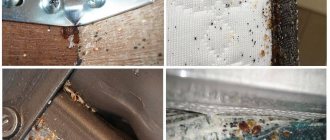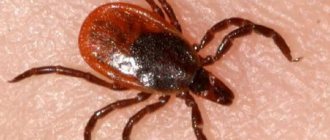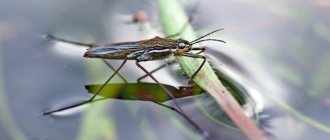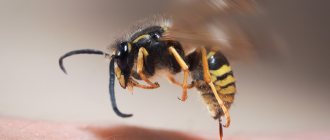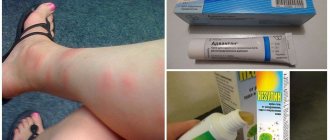How mosquitoes bite
In mosquitoes, only females fly out to hunt, since their need for food increases after fertilization - feeding is necessary for the full development of eggs.
During the night, a mosquito is able to attack up to 20 times, if it has unhindered access to the victim. The female strives to get fully drunk in one go, which is twice her weight - 5 ml. Mosquitoes attack places that are not covered by anything: legs, arms, shoulders, neck, back. Even the scalp will not become an obstacle for them. The peak of activity occurs at dusk, but can also bite during the day. The marks remain on the body in a chaotic manner.
The mosquito pierces the skin, then injects a substance with saliva that prevents blood clotting. This makes the saturation process easier. A person feels a harmful attack instantly, due to the appearance of acute pain and burning. Literally after a couple of seconds a blister and redness appear, followed by itching.
The body reacts differently to a mosquito bite, but in most cases the signs are as follows:
- swellings, up to 5 mm in diameter;
- presence of swelling during the first 2 hours;
- disappearance of itching after alcohol treatment of the affected area;
- unpleasant symptoms disappear within a day on their own;
- the epidermis is quickly restored.
In people with a predisposition to allergies, symptoms are more pronounced and severe. Sometimes even medical intervention is required.
There is no systematic pattern in mosquito attacks - they can bite at night and retreat through an open window during the day. Bedbugs are a nuisance every day.
Bedbug bite
Bed bugs function equally actively, regardless of the seasonal period. They settle close to humans - the main source of food. The optimal conditions for their life are temperature within 20-30 °C. They form nests mainly near a sleeping person - in sofas, beds, armchairs.
Bloodsuckers crawl out to hunt at night - from 3 to 7 am. They follow the scent of a sleeping victim, focusing on calm breathing. Since when they bite they release an anesthetic substance, the person does not immediately feel anything.
An adult female parasite feeds once every 7-9 days, larvae - daily. Due to this feature, bites on the body appear periodically. This makes it difficult to timely detect pests indoors. But with mass infection, bloodsuckers begin to feed more often. An adult spends about 20 minutes to satiate, nymphs get drunk in 2-3 minutes.
In one go, the mosquito needs to drink up to 7 ml of fresh blood. Since this does not succeed at first, the parasite crawls away and makes a second attempt. There can be up to 25 such injections, at a distance of 1-4 cm. Therefore, the trail looks like a chain. Since parasites go out hunting in groups, a person can get up to 500 bites per night.
The bug is equipped with a special proboscis with a sharp tip. When punctured, the anesthetic is released with saliva. While the victim does not feel anything, he sucks the blood. The result is a bulge with a red dot in the middle. For allergy sufferers, such attacks can cause serious consequences: urticaria, Quincke's edema and even anaphylactic shock
The resulting severe itching cannot be relieved by anything. Sometimes you have to resort to pharmaceuticals.
How a bug bites
At first glance, the marks of bedbug bites are no different from mosquito bites. But if you got rid of the winged bloodsuckers and no one buzzes over your ear at night, but marks appear on the skin, these are bedbug bites. Bed parasites can be recognized by wounds on the skin.
- The bites are arranged in rows. The bug bites several times in a row and the marks form a path on the body. The lesions are located at a distance of approximately 3 cm from each other.
- The wounds form a circle of redness and a pronounced core - the “head” of the bite. The puncture site itself becomes brown in color.
- Another way to distinguish a mosquito bite from a bedbug bite is the location of the wound. A mosquito can only sting exposed areas of skin; the bug bites all over the body, trying to find places where blood vessels pass closer to the surface of the skin.
- Bedbug bites itch longer and do not go away on their own, as is the case with mosquito bites.
- Itching appears. After a bug attack, itching does not begin immediately, but 20-30 minutes after the bite. If you haven’t heard mosquitoes, but suddenly itching and redness appear, it’s time to wonder if you have bedbugs.
What is the difference between a bedbug bite and other insects?
Traces of bedbug bites can easily be confused with dermatitis and wounds from linen lice. But there are features by which a correct conclusion can be made about the origin of the rash:
- If a tick bites, a large seal forms around the puncture. It is common for him to bury his head under the skin. Unlike bedbugs, tick bites are painful.
- Due to night attacks, bedbug bites are discovered in the morning. Irritation on the body from mosquitoes appears at any time of the day, but more often after a walk in the park or on the street. Stains can occur when flying insects enter the home. But they announce their presence by squeaking.
- Bites from stinging insects - bees, wasps, bumblebees - are accompanied by severe pain. In addition, they sting during the day. The bug bites at night unnoticed by humans.
- Traces of the nightly feast of bedbugs resemble flea bites. But flea wounds are randomly scattered throughout the body, mainly on the legs. They leave no bloody stains behind. Paths are typical for bedbugs.
- Allergic rashes vary in nature and location. Bedbug tracks are located on open areas of the body. While allergies occur on any segment of the skin. In addition, on the cone of the bug there is a visible puncture point with the proboscis. With dermatitis of any origin, such a sign is not observed.
- The rash from chickenpox affects the skin and mucous membranes, which is not typical for bedbugs.
If any spots appear on the skin, it is best to consult a dermatologist. A specialist will determine what kind of bedbug bites and how to treat them.
How to find out which insect bit you: a bug or a mosquito
Features of bites:
- Externally, if it is summer time, then it is quite difficult to distinguish the bites of these bloodsuckers. Especially if there are a large number of flying insects in the house or you accidentally fell asleep in nature. In this case, a decent number of red, raised spots will appear on the body, which are characteristic of a mosquito bite. But if you notice such bites in the winter, you should think about it, because there is a very small chance that in winter it will be mosquitoes flying in your room, and not bedbugs.
- As for mosquito bites, these bloodsuckers usually bite in places not covered by clothing, that is, bare. Bedbugs are much more agile; they can bite places that are under clothing. Because they do not fly, but crawl, and can crawl anywhere, including under clothing, even if it fits quite tightly to the body. Accordingly, if you wake up in the morning and find red spots that are under thick clothing, most likely you were bitten by bedbugs, not mosquitoes.
- Another distinctive feature of bedbug infestation is the presence of severe itching. When they bite, they break through the skin. To ensure that the victim does not feel the bite and cannot throw off the parasite, they secrete a special anesthetic that causes a very severe allergy. Therefore, 20-30 minutes after the bite, severe itching begins. The area may become swollen.
- Very often, young children scratch such lesions, thereby introducing a secondary infection, staphylococcal or streptococcal. Thus, a combined infection is obtained, which contains traces of allergies, as well as bacterial damage. Please note that mosquitoes, especially females, can be quite aggressive, so they buzz a lot and can land several times on the place from which they are driven away.
- In addition, bedbugs never bite into the skin with their jaws just once. To get enough, they need about 7 ml of blood. To obtain this amount of liquid, it is necessary to pierce the skin several times in different places. This creates a kind of trail of bites and red spots. In addition, such spots, unlike mosquito bites, have a pronounced apex, because the bug has massive and pronounced jaws that pierce the skin quite strongly. This leaves a blood clot on top, called a red spot, which usually resembles a wound after the skin is damaged by baking the blood.
Patterns of bites of various insects
How to treat bedbug bites
It is quite difficult to cure bedbug bites, but there are several remedies that will relieve the symptoms.
Unpleasant sensations such as itching, swelling, redness - all of them can be significantly reduced with the help of ointments or suspensions. Treating bite wounds will help prevent more serious illnesses and infections. Bed bug bites are not dangerous! The saliva of these bloodsuckers does not contain carriers of infections or viruses.
Combing the marks is much more dangerous, because a bite is an open wound with access to the body’s circulatory system. Any infection that enters the bloodstream will spread to the organs in a matter of minutes. Moreover, bedbugs, feeding on blood, leave their excrement near the wound and a person can accidentally introduce it into the blood
Therefore, it is important to clearly understand the sequence of actions if you find marks of insect bites on your body
- Wash the wound (bite) thoroughly with soap. Try not to injure the wound, wash gently or simply apply foam.
- Leave the soap suds on the wound until it dries completely. This will help reduce itching, disinfect the wound and wash away the remains of the bedbug.
- Take an allergy medicine, even if you don't have one. It may well be that you have not been bitten by bedbugs before and the allergy will manifest itself from this. You can buy any antihistamine at the pharmacy; you don’t have to buy a very expensive or well-known one.
All actions are aimed at minimizing the discomfort experienced by the victim of an insect attack and eliminating the symptoms of bites. Namely: remove redness, reduce itching and swelling. Painkillers can help reduce pain, but their use may cause side effects. It is best to consult your doctor before taking any painkillers.
(Video: “What to do after insect bites (mosquitoes and midges)? What will help with severe itching?”)
The danger from bedbug bites to humans is so small that medicine has not even provided any special treatment for this case.
There are no studies that confirm or refute the effectiveness of treating insect bites. In other words, they will most likely go away just as quickly as without treatment.
However, the use of medications can, at a minimum, reduce symptoms (itching, redness), and therefore make the patient’s recovery process calmer.
Ointments
If you are bitten by bedbugs, you should purchase an ointment or gel at the pharmacy that promotes wound healing. After all, a bite, as we discussed above, is an open wound. Yes, visually it doesn’t look like that, but practically it’s true. For example, you can use Cortade anti-inflammatory ointment. It contains cortisone and hydrocortisone. These substances help reduce itching, and you can buy the ointment at any pharmacy.
Cortisone and hydrocortisone help reduce itching, so any ointment or gel based on them can help reduce scabies.
Lotions
Lotions can also help relieve suffering and reduce itching. Calamine lotion dries out the skin and can protect against infection, leading to faster healing.
If you consult a doctor, he may prescribe more serious medications - corticosteroid ointments. They are more effective for a certain group of people, but also have side effects.
ethnoscience
Some remedies that can be done at home are worth knowing even if you are not a supporter of traditional medicine. After all, bites can catch you not only at home, but also in nature, on a hike, on a tourist trip, etc.
To relieve symptoms, you can use the following remedies (available at home or at your local supermarket):
- lemon juice;
- aloe;
- vinegar;
- baking soda;
- mint;
- dandelion leaves;
- chopped onion.
Lotions from the products listed above will help relieve itching and remove redness. Of course, using these methods will not help the marks disappear faster, but it will become much easier for you to endure the course of the disease.
Using vinegar may seem painful, but it works great for stings! Soak a cotton swab in vinegar and apply to affected areas. At first you will feel an unpleasant tingling and burning sensation, but it will pass quickly. After just a couple of minutes of use, you will no longer feel itching, and redness and swelling will noticeably decrease.
Mint leaves placed around the bite will help relieve pain and swelling. Crushed dandelion leaves, fresh potato juice, or parsley juice are also great for relieving symptoms. Applying an ice cube will also help relieve itching and swelling.
What are the differences between mosquito bites and bedbug bites?
At first glance, it will not be possible to distinguish who bit - a bug or a mosquito. The affected area turns red, is very itchy and begins to itch. For this reason, many may think that a mosquito did it.
Mosquitoes are easy to spot. Parasites become active at night, begin to fly, squeak annoyingly, land on the body, and bite. And if there are several of them, they will probably not let you sleep.
It is noteworthy that apartment bugs do not manifest themselves in any way; they quietly crawl around the apartment, find a victim and attack it. Their bite is quite unpleasant, it is somewhat reminiscent of a mosquito.
So, there are quite a lot of similarities, but there are still differences, the presence of which will help clarify the situation for those who really want to know how to distinguish a bug bite from a mosquito bite. Let's consider the characteristic features.
Appearance
It is impossible to distinguish between a mosquito bite and a bedbug bite.
It has common external features:
- red pimples appear on the affected areas;
- redness and swelling gradually appear;
- a small dark dot of dried blood is found on the blister;
- there is a feeling of severe itching.
However, with bedbug infestations, the itching sensation is much stronger. The location of the bites has a sequence in the form of paths.
A female bedbug drinks 7 ml of blood in one meal. Suction of this amount lasts 20 minutes. During this period, the insect attacks several times at a short distance. Tracks remain on the surface of the skin, and the blisters are placed in pairs.
Bedbug infestations are accompanied by severe pain and itching. They heal slowly, and the feeling of irritation may persist for several days.
The final restoration of the cover without the addition of infection and allergies occurs after a week.
Localization of bites
Bedbugs choose open areas of skin with close blood vessels. Bloodsuckers often attack the neck, back, arms, and legs. Mosquitoes attack everywhere, and their bites look like separately located red pimples or blisters.
They attack the entire body, starting from the heels and ending with the head. But bedbugs will not infect the abdomen, chest, or head.
Bedbugs prefer delicate skin, so they often attack women and children, but men suffer from them much less often.
They attack open areas of the integument, but in severe hunger they can crawl under the covers.
Reaction to bites
It is not always possible to distinguish between damage from bedbugs and mosquitoes, because they have similar symptoms.
The following unpleasant reactions can be detected on the surface of the skin:
- red spots appear;
- when combed, they increase in size;
- after a while, instead of spots, red blisters appear, in the center of which a dark dot of dried blood is found;
- the affected areas may swell greatly.
The difference between mosquito bites and bedbugs is that they can be located all over the body.
Parasites can bite through the skin in any area, and the lesion is always accompanied by pain and itching.
Consequences of bites for the body as a whole
Bedbug and mosquito bites are especially dangerous for children. Together with saliva, these parasites can introduce dangerous infections into the blood. They often cause severe allergies, which can pose a serious health hazard.
Insects can introduce dangerous bacteria and microbes into the blood, which can subsequently lead to the following dangerous diseases:
- parasites can spread HIV infection from another infected person;
- various viral diseases;
- plague;
- tularemia;
- fever;
- skin rashes;
- any other dangerous infections.
How are bedbug bites different from mosquito bites?
Mosquitoes are probably the biggest pests during the warmer months of the year. They bite us because they need blood protein for their eggs. Only females attack. They inject a protein that blocks blood clotting so they can feed on us fearlessly. Our body, however, is allergic to this protein.
What do mosquito bites look like? From a mosquito feast, blisters quickly form, ranging in size from 0.2 to 0.5 cm in bad cases and more. The spot itches a lot, but does not hurt. The middle often appears whitish with a red border. Blood is usually not visible.
To know if you were bitten by a mosquito and not a bedbug, compare these signs of a bite with the bedbug bites listed below.
Clue!
It is enough to see that the bites do not follow each other, but are randomly scattered throughout the body, to diagnose that this is a mosquito bite and not a bug bite.
Why are bedbug bites dangerous?
Many people think that, as in the case of mosquitoes, there are no consequences from bedbug bites other than redness and itching. Actually this is not true. Small parasites can become carriers of infectious diseases.
The itching causes an unbearable desire to scratch the bite site; this is strictly forbidden. It is easy to get an infection into the wound, and complications are not far away.
Multiple stings cause swelling, which can be quite painful.
For children, who suffer more from parasite bites, bedbugs are dangerous as allergy triggers. The allergic reaction also occurs in adults. A bug bite causes an allergic attack due to substances contained in the insect's saliva.
You shouldn’t discount the fact that bedbug attacks at night can deprive you of sleep. Irritation and depressed psychological state have a bad effect on performance.
If it is difficult for you to independently identify a bedbug bite, seeing many marks on the skin from an insect attack, consult a doctor.
How dangerous are bed bug bites?
A bug is an insect that feeds on the blood of people, birds and animals. The adult size reaches 8 mm. Color – light brown. Filled with blood, its color ranges from bright red to black.
In the process of evolution, nature ordered that bedbugs do not carry infectious diseases and leave their victims “clean”. A bug bite causes the following reactions in the body:
- Allergy. When tissue is damaged, the insect releases enzymes that cause allergic reactions, including anaphylactic shock. In this case, immediate hospitalization and subsequent examination of the body are necessary to identify the causes of the severe reaction.
- Erosion of the skin. Appears due to an inflammatory process on the surface of the epithelium. The affected areas cause itching and burning.
- Swelling of the affected areas. The swelling does not cause pain and subsides after 1-2 days.
- Hyperemia. The vessels of the circulatory system located at the site of the lesion become overfilled, and the outflow of arterial blood is disrupted. Redness appears and the local tissue temperature rises.
- Loss of consciousness, vomiting. Possible in rare cases.
The listed symptoms do not occur in everyone; rather, these are isolated cases. The most common consequence is a rash that does not go away for a long time.
The bug does not carry infectious diseases. It causes the greatest harm to the psychological state of household members. The photograph of a bug is unpleasant; despite its small size, harmful insects cause fear in both adults and children.
People who have bedbugs in their home suffer from insomnia and psycho-emotional disorder. Against this background, the body’s overall immunity decreases, you become irritable, overexcited, and chronic fatigue haunts you.
Scratching bedbug wounds can introduce infection, which can lead to additional health consequences. If the size of bedbug bites increases and pus appears inside, consult a doctor immediately.
And in order to begin pest control, you need to know what house bug bites look like in order to correctly diagnose the problem and choose the right solutions.
What is the difference between a bug bite and a midge bite?
A small black insect annoys people outdoors during the warm season. Almost never appears indoors. But, if we take into account the fact that a person may not notice bites immediately after waking up, but before that there was an outing into nature, we can assume.
The peculiarity of a midge bite is a dark blood spot in the center. The insect doesn't just pierce the skin, it chews it out. The process is accompanied by severe pain. The person reacts almost immediately. There is a circle of redness and slight swelling around the bloody spot. The midge bite is very itchy. Much worse than a mosquito or flea. Pimples are arranged in any form, there is no chain. The midge bites exposed skin. Arms, legs, necks, and children’s faces suffer. The bite does not go away for a long time. You may experience discomfort in the affected area for about a week. Midges annoyingly attack in groups, but bite individually. Therefore, a large number of acne can be immediately detected by a person who has slept very soundly, and in nature. Bed bugs prefer a home environment.
What is the difference between a bug bite and a flea bite?
The small insect is considered a parasite of domestic animals. Moreover, cats do not live on dogs, and dogs do not like the blood of cats. A person is attacked only as a last resort, or when the premises are severely infested. But even in the absence of pets, fleas can live in the house. For example, earthen ones. They enter from entrances, basements, and can come in with shoes and clothes from the street. There is another type of flea - bed fleas. If you get these in your house, you can certainly confuse them with bedbugs.
Fleas bite in places where the skin is thin.
- Axillary, popliteal cavities;
- Legs – calcaneus, top of the foot;
- Waist.
There are flea bites on other parts of the body. Especially if the premises are heavily infested. A distinctive feature is the absence of bloody spots in the center. Because the skin puncture is too small. Pimples are more like spots, often without much swelling. The insect bites several times. The distance between bites is no more than 1–2 cm. Itching is present, but not constant. The marks go away on their own within 5 days. Bed fleas become active in warm and cold seasons. Moreover, like bedbugs, they live in a person’s sleeping place. Their bites are distinguished by smaller pimples and the absence of blood spots in the center.
How to distinguish a bug bite from acne
Some people have doubts about bites. They just think it's acne. As a rule, acne of a certain type appears on the body - subcutaneous, open. Open pimples look like red swellings, with a sign of an abscess in the center. Painful touches. The middle can be squeezed out. Subcutaneous pimples reveal themselves as severe swelling, pain, without an affected area in the center. In addition, acne appears in certain areas of the body. Where are the most sebaceous glands located? After all, one of the main causes of acne is clogged pores. Therefore, they can be found on the face, back, neck, and chest. In addition to this, bedbugs bite your legs and arms. Pimples appear randomly. It is impossible to trace the chain. Assuming that this is acne due to diseases. Other characteristic symptoms of the disease must be present.
In general, it is impossible to confuse a bug bite with ordinary acne.
What do bedbug bites look like?
At first glance, bedbug bites can easily be confused with the bites of other insects, such as mosquitoes, or with a nettle sting, however, the bites left by bedbugs still have some distinctive features that make it possible to accurately determine who they belong to.
What do bedbug bites look like?
- A bedbug bite appears as a red, dense dot, measuring 0.1 to 1 millimeter in diameter.
- Several of them always appear and form paths of red dots.
- If you scratch the bites, large red spots appear around them due to skin irritation.
- Scratched bites look like bleeding spots on the body and may leave a scattering of small scars.
If you still have a vague idea of what bedbug bites look like, a photo of them will help clarify your ideas about the nature of the damage.
What are the dangers of bloodsucker attacks?
Annoying itching and painful swelling at the site of the lesion are not the most pleasant sensations, but bites of blood-sucking insects also have much more dangerous consequences.
Mosquitoes are carriers of dangerous diseases such as:
- dirofilariasis;
- malaria;
- types of tropical fevers;
- meningitis;
- tularemia.
Serious infections enter the human body as a result of bedbug attacks:
- typhoid fever;
- smallpox;
- brucellosis;
- anthrax;
- Hepatitis B.
If a person is attacked by several bedbugs at once, it is even possible to develop anaphylactic shock. Children who are constantly bitten by bloodsuckers develop anemia, irritability and depression due to lack of proper sleep.
However, it is worth recognizing that HIV and other deadly diseases transmitted through blood are not transmitted by mosquitoes or bedbugs. The proboscis of insects only works to pump out blood, so that the blood of a sick person does not enter the body of a healthy person through pest bites.
Bloodsucker bites cause allergic reactions, which manifest themselves as:
- redness of the epidermis;
- allergic dermatitis and rashes;
- increased body temperature, fever;
- headache;
- difficulty breathing;
- swelling of the mucous membranes.
Secondary infection of scratched wounds is also dangerous, which in extreme cases leads to blood poisoning.
Mosquito and bedbug bites are similar only at first glance. Knowing the behavioral characteristics of insects and the body’s reaction to an attack by one or another pest, it is easy to determine who is the culprit of the unpleasant sensations.
Both situations have one thing in common: it is recommended to treat the bite sites with a disinfectant and not scratch them, so as not to introduce bacteria and infections.
Is a bedbug bite dangerous for humans?
Under normal conditions, when a person has a low level of sensitivity, there is no tendency of the body to allergies, there are no chronic diseases, including those of a dermatological nature, contact with parasites will not entail any serious consequences. If you are wondering why bedbug bites are dangerous, you need to remember that such insects do not transmit infections to humans, although they are carriers of the most severe of them (typhoid, anthrax, hepatitis, etc.). This is due to the structure of the oral apparatus.
However, if a child or an adult with a tendency to allergies or hypersensitivity is bitten by a bug, then the symptoms become stronger: the red spots increase, the skin in these areas swells, itches severely, and pain appears. The person's general condition worsens. Bug bites are dangerous in these cases, because the allergic reaction can be so strong that bronchospasm occurs and anaphylactic shock develops. Other pathological conditions that accompany the appearance of punctures on the skin:
- inflammation in places where the integrity of the skin is compromised;
- deep wounds in areas where bites are located, which occur due to scratching against a background of severe itching;
- psychological disorders: insomnia, irritability, aggressiveness, increased fatigue.
This means that the answer to the question whether a bedbug bite is dangerous for humans will be positive, but not always, but only if a number of conditions are met.
You should consult a doctor if a negative reaction continues to develop, even when its cause - the allergen - has been eliminated, as well as in cases of complications. You need to show the bites to a specialist, he will prescribe an appropriate symptomatic treatment regimen.
Why do bed bug bites itch?
The oral apparatus is designed in such a way that it contains separate tubules: for administering a substance whose properties resemble a local anesthetic, as well as for sucking blood. If the parasite is immediately saturated with blood, the person will feel pain and eliminate its cause. Therefore, nature took care of the safety of insects at the feeding stage. In this case, the parasite first injects an anesthetic substance contained in its saliva. Then he begins to feed. As a result, negative symptoms do not develop immediately.
Before a person feels severe itching from a bite, the body is exposed to a strong natural anesthetic, which the bug injects while eating.
Severe itching occurs suddenly when the anesthetic wears off. At the same time, pain may appear. It all depends on the body’s reaction, which develops as a response to the entry of foreign substances into the blood. The immune system suppresses the pathological process, which is accompanied by itching and an inflammatory reaction.
How long does it take for bedbug bites to go away?
It is impossible to predict when the signs of insect infestation will disappear. This is due to the fact that the body’s reaction to an allergen is always individual.
However, there are several general scenarios for the development of a situation when parasites attack:
- traces of bedbug bites disappear quickly - within the first day, sometimes much faster (in 12 hours), but in this case the spots are small in size or absent altogether, and in their place red dots (dried blood) appear;
- if you are wondering how long bedbug bites last with moderate development of the pathological process, in this case, eliminating signs of contact with parasites takes 3-5 days;
- if complications occur, recovery may be delayed, elimination of signs of an allergic reaction often occurs in 2-4 weeks, more severe complications (secondary infection, severe skin damage, anaphylactic shock, bronchospasm) require long-term recovery, and sometimes scars remain on the skin, for example, if The child scratched violently at numerous bites.
Causes of a mosquito-like rash
When pimples appear, mosquito bites make you itch, which is not always possible to understand. To do this, you need to compare the rash with the usual mosquito and identify inconsistencies.
The problem may lie in:
- Damage to tissues by various blood-sucking insects.
- Allergic reaction to food.
- Prickly heat.
- Infectious pathologies.
- Allergic urticaria.
- Vascular diseases.
- Development of meningococcal sepsis.
Nutritional atopy
Sometimes food allergies resemble mosquito bites. It can occur with any product and in severe situations can even lead to anaphylactic shock.
A distinctive feature of atopy is that pimples appear even under thick clothing and can merge. A food allergy on the skin like the mosquito bites in the photo can subsequently change color, shape, and size. Atopy appears suddenly after ingesting an allergen. If you take an antihistamine, the symptoms decrease. Patients also complain of nausea, vomiting, abdominal pain, and sometimes an increase in temperature.
Prickly heat
Spots on the body similar to mosquito bites may appear due to non-compliance with the thermal regime. Miliaria is more common in infants and is observed in the form of a small rash on the neck, forehead, back, and chest. In severe cases, blisters and purulent rashes form. In this case, the pimples look like mosquito bites.
A distinctive feature is the increase in temperature.
Infectious pathologies
When acne appears, like the skin itches after a mosquito bite, the reason may lie in a number of infectious pathologies:
- Measles. When the virus enters the body, catarrhal manifestations and rashes are observed throughout the body. Subsequently, the spots turn brown. During the incubation period, the temperature may rise significantly.
- Chickenpox. Most often diagnosed in childhood. The rash appears gradually and resembles blisters. There is a clear liquid inside the pimple; if it bursts, it will leave a scar for life. Usually the pathology is mild, but may be accompanied by fever, weakness, and conjunctivitis.
- Rubella. Red rashes have a bump in the middle. The disease progresses with catarrhal symptoms: rhinitis, conjunctivitis, redness of the throat.
- Scarlet fever. The disease occurs with fever, sore throat, and red rashes.
- Molluscum contagiosum. The rash looks like small bumps with a white center inside. They can stay on the skin for a long time without causing any discomfort and are able to go away on their own.
- Roseola. It is characterized by an increase in temperature and the appearance of a pink, raised rash. Papules usually do not bother you and go away on their own in 3-4 days.
Allergic urticaria
It occurs against the background of an allergic reaction to household chemicals, dust, pet hair, and clothing. The rash resembles pink blisters, similar to burns. The patient feels weakness, itching, burning.
Diseases of the blood and blood vessels
Pimples appear in the problem area as if caused by a mosquito bite. In addition, small bluish areas resembling bruises form nearby. Typically, a rash appears when tissue is injured.
Meningococcal sepsis
The patient is concerned about hyperemia and rashes. Symptoms increase rapidly, so immediate medical attention is required. Usually papules are localized on the legs. Over time, they transform into purple subcutaneous spots.
Allergy symptoms
Urticaria, or urticaria, is characteristic of an immediate allergic reaction, and therefore occurs within a few minutes after contact with the allergen.
Photo: characteristic appearance of allergic urticaria
The symptomatic manifestations of urticaria are similar to those caused by a nettle sting or an insect bite. It is due to the identity of the type of rash that allergies are similar to mosquito bites. Below are the main symptoms indicating an allergy.
- With this condition, blisters appear on the skin throughout the body - small, dense, swollen, raised elements of a round or irregular shape that can merge with each other. Please note that the rash in this case also occurs in areas covered by clothing
- The blisters are pale pink in color, and the surrounding skin is normal or reddened. The rash is accompanied by severe itching.
- Unlike a bite mark, which can remain unchanged for a long time, the rash disappears without a trace after the cessation of exposure to the allergen.
- The allergic reaction disappears quite quickly or becomes symptomatic when taking antihistamines
- People around you do not have any symptoms of the rash.
Actually, allergic reactions also occur to mosquito bites and other insects (especially in children) and there are few of them that can be confused with.
Familiarize yourself with the characteristics and treatment of this allergy, as well as photographs of allergic reactions to mosquitoes and other midges.
First aid for allergic urticaria
The first step is to stop exposure to the allergen if possible. Next, if prescribed by a doctor, you must take an antihistamine (loratadine, fexofenadine, cetirizine). To reduce itching, you can use sunburn cream, and also change to cotton clothes.
Please note: On our portal you can read a detailed article about the symptoms, types and treatment of urticaria
If Quincke's edema develops, low blood pressure, nausea, vomiting, or loss of consciousness, you should immediately call an ambulance.
Treatment of allergic urticaria
Photo: Rash in the form of insect bites on a man's hand
The action of the allergen that caused the reaction ceases. In addition, the patient should switch to an elimination diet that excludes foods with a large number of allergens (chicken, citrus fruits, nuts, eggs, strawberries, spices, foods with a high content of dyes).
In acute cases of urticaria, antihistamines are prescribed.
In the case of the development of a severe form of the disease, infusion antihistamines, corticosteroids (prednisolone, dexamethasone), calcium preparations that reduce sensitivity to allergens (calcium chloride or gluconate) are used; when the allergen is taken orally, gastric lavage is performed, and activated carbon and other sorbents are also used.
For urticaria, the use of codeine, aspirin, including its derivatives, and ACE inhibitors is prohibited.
